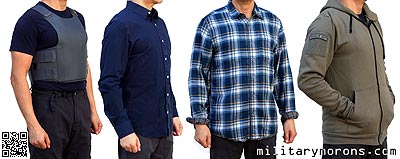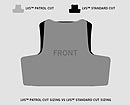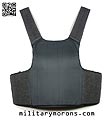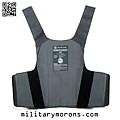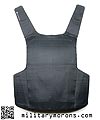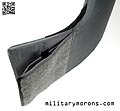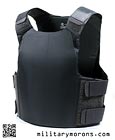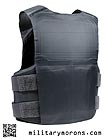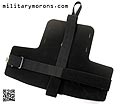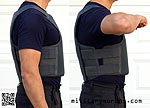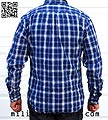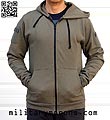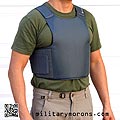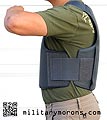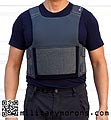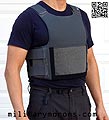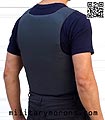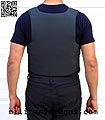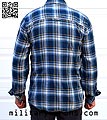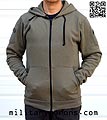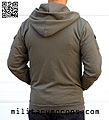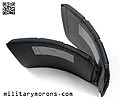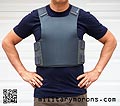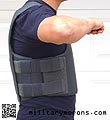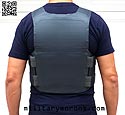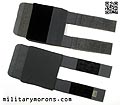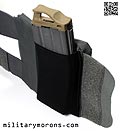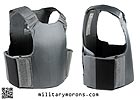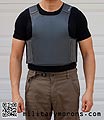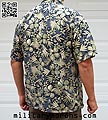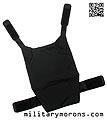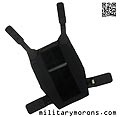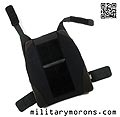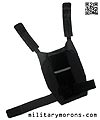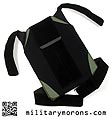CRYE PRECISION PAGE 1 PAGE 2 PAGE 3 PAGE 4 PAGE 5 PAGE 6 PAGE 7 PAGE 8
TO VIEW FULL SIZE IMAGES: USERNAME and PASSWORD are both "mm"
Crye Precision LVS (Low Visibility System)
| 12/19/17 - The Low Visibility System (LVS) from Crye Precision sets the standard for concealable body armour. Using proprietary 3 -dimensional forming technology; the vest is shaped to directly match the contours of the human body, increasing comfort and concealability while eliminating the crumpling and folds typical of standard soft body armour panels. The LVS is a Certified NIJ IIIA scalable, modular system that enables the user to combine items to configure anything from a concealable low-vis vest to a fully armoured tactical entry vest. The entire system is modular and designed for quick and easy switching of components to meet different threats and mission requirements. It debuted at the 2016 SHOT Show. Overview - Of the many different types of body armour available, the most commonly seen in everyday life is the 'soft armour' vest worn by most law enforcement officers, bank security guards etc. Soft armour is so named because the armour panels are flexible, as opposed to 'hard' armour plates. Soft armour is typically rated to stop handgun bullets, while stopping rifle bullets requires plates. Ballistic plates are more commonly used by the military or high-threat LE entry teams, in an 'overt' manner (concealment is not a factor). In the United States, the most commonly accepted standards for bullet resistance are the NIJ (National Institute of Justice) ratings. For soft armour, the ratings (or 'threat levels') are IIA, II, IIIA and are limited to handgun ammo. Protection from rifle bullets falls under the II and IV ratings. The term 'concealable body armour' is used loosely to categorize most soft armour systems as they consist of panels of a ballistic fabric woven from a synthetic fiber like Kevlar®, Spectra Shield®, Dyneema® etc that conform (somewhat) to the wearer's body; and can be worn under a uniform, somewhat discreetly. Hard armour plates, on the other hand, are not flexible and will not bend, making concealment much more challanging. Discreet, however, doesn't always equate to 'concealed' - there's a difference. For uniformed law enforcement officers on patrol or security guards typically identified by a uniform, true concealabilty is not needed. Take a look at the next police officer you see; their vest's outline is quite noticeable when you're looking for it. There will be circumstances under which true 'concealability' is desired; the wearer will need to hide the fact that they are wearing body armour under 'normal' clothing; and appear completely ordinary to the casual observer. The main factor preventing soft armour from being completely undetectable is 'printing'; when the shape or outline of the soft armour panels are visible from under the wearer's clothing. Soft body armour panels always have a thickness; and that thickness varies depending on the threat level rating and material that the panel is made from. Most Level IIIA soft armour panels I've seen are typically around .350" thick. Slightly less for the lower rated panels. Typical soft armour panels are made flat, and are cut into patterns such that they will wrap around the wearer's body. While they are flexible and can be folded in half, like a sheet of paper, the problems arise when you try to bend them in the third dimension. Try conforming a sheet of paper to your chest and you'll see that the the paper will conform nicely in one axis, but not in the other. It's like trying to wrap a round present vs. a box-shaped one with wrapping paper. Edges will stick out, the panel will want to fold and kink. The human body shape doesn't have straight edges. Crye addressed this issue by turning to 3-dimensional forming technology, which molds the LVS panels to match the contours of the human body, reducing the likelihood of visual printing and bulk. LVS Base Vest Patrol Cut The Crye LVS Base Vest is available in Standard and Patrol Cut. The only difference between the two is that the Patrol Cut is slightly narrower across the upper chest for improved mobility of the arms (when firing a handgun two-handed, folding your arms across the chest, or shouldering a rifle for example). The LVS Base Vest Patrol Cut is featured in this write up. Typical soft body armour systems consist of the ballistic panel inserts, and some sort of fabric carrier. The simplest 'traditional' carrier usually consisted of front and back panel covers connected by elastic straps that were velcro adjustable. The inserts would be removed when it was time to launder the carrier. The rear insert is normally wider to provide more back coverage, sometimes with 'wings' that wrap around the sides to the front, overlapping the front wings. The issues with these vests was that there would always be some curves around which the panels would trouble conforming to; creating edges which could be seen through clothing. Carriers also added bulk and contributed to the printing issue. Since the panel inserts were unsupported and just rested on the bottom of the carrier, there would sometimes be crumpling or folding at the bottom. Another issue was with the ballistic panels themselves. To protect them from moisture/sweat/oils, the ballistic panel inserts are commonly placed within water-resistant covers that are heat sealed around the perimeter of the panel. The covering fabric itself tends to crumple and crease, as it's not actually attached to the panels. IAV (Insert As Vest) architecture - Crye addresses the issues inherent to insert/carrier systems by eliminating the carrier on their Base Vest. The Base Vest requires no external carrier at all. The 3D-formed ballistic panels are laminated permanently to very thin, low profile water-resistant material, which is shaped and sewn to include all the necessary attachment and adjustment features. This creates a panel that does not require an additional cover, that doesn't crease or collapse, and offers the lowest profile currently possible with a ballistic vest with IIIA protection. Manufacturer specs and features for the Crye LVS Base Vest are as follows:
In a nutshell, the Type IIIA rating provides protection against .357 SIG, .44 Magnum, 10mm Auto, 7H21 as well as the threats covered in IIA and II ratings (9mm +P, .357 Magnum, 9 X19mm, .40 S&W, .45 ACP, .22LR, .380 ACP). For more specifics on testing standards, bullet weights and velocities, visit the NIJ website. Also note that the LVS is Certified NIJ IIIA as opposed to just being 'compliant'. The Certification process is a much more complex testing procedure. Base Vest details - The LVS Base Vest System comes with front and back vest panels, 2" and 4" wide side straps, and the LVS Storage System. The Base Vest only comes in a medium gray colour, with integral low profile shoulder straps extending from the top corners of the front and rear panels. Covering fabric is smooth with a slight sheen to it, and is laminated directly to the ballistic panels themselves. The panels are pre-shaped/contoured, and are .300" thick. On the inside, the black vertical areas are stretch material to prevent bunching of the covering fabric at the areas where the panels curve around to the sides. Everything on the Base Vest has been designed to reduce signature; low profile straps, no big seams, smooth exteriors. The LVS Base Vest is supplied with four 2" wide side straps. An optional set of 4" wide straps is also included (more on that further down). The 2" wide side straps are elastic, with velcro on them. I really like having the straps not sewn to the vest as they're easily replaced should the elastic get worn out (that's happened to me on soft armour carriers before - the elastic got old and stretched). The straps are attached to the rear panel. The rear panel has a back channel into which the side straps are inserted, and retained with velcro. To first set the adjustment of the side straps, the LVS is put on with the side straps attached to the front panel only. The appropriate strap length is determined by seeing whether the straps naturally align with the rear channel. Crye recommends folding the strap over so that the velcro isn't engaged yet, and inserting at the right position into the back channel. The strap is then rolled into the channel to secure it in place. I found it also helped to cut out a piece of cardboard to prevent engagement of the strap and channel velcro while adjusting/aligning the strap, then sliding the cardboard out to lock the straps in place. The ride height of the LVS is adjusted by varying the length of the the overlapping shoulder straps.
The loop velcro ends of the side straps can be trimmed with scissors if they're too long. The ends of the straps should not overlap in the center of the back channel, as they can form a lump that might be seen through clothing. There are two very low profile elastic pockets built into the front panel 'wings', which can be used to hold an M4 magazine, radio etc.
Care - To clean the vest, first remove any dirt with a soft brush. Wipe down vest with a damp cloth soaked in warm water and air dry in a shaded space. Do not machine wash or dry clean. Do not apply iron or any heat to the base vest. LVS Storage System - The LVS Base Vest comes with a storage system that helps it maintain its shape. It is recommended that the LVS is placed in the Storage System all all times when the LVS is not being worn. It is especially important to use the Storage System if the LVS is left in a hot vehicle. Leaving the LVS out in direct sunlight or enclosed in a hot vehicle may cause it to lose its form if laying flat. The LVS Storage System is a flat sheet of 0.125" thick ABS plastic with removable vertical and horizontal straps. To store the Base Vest, the back panel is placed in the Storage System and the front panel is twisted to fit inside the back panel. The vertical velcro strap is then connected; it does not have to be very tight. The horizontal strap is then connected and tightened until the Storage System form is in a curved position. A hang loop is provided for hanging the Base Vest and Storage System inside a closet.
Custom shaping the Storage System form - I asked Crye whether the Base Vest would change shape slightly to conform to the individual wearer over time, and they said that yes, it would (within reason). I don't stand up very straight, and my shoulders naturally slump forward a bit (bad posture). As a result, I noticed that the top rear corners of the back panel didn't follow my rounded shoulders as closely as they could have. Instead of waiting for the corners to conform more over time, I decided to try speeding things up. I asked Crye whether it was possible to heat up the ABS Storage System carefully with a heat gun to reshape it, and while they didn't recommend it, they replied in the affirmative, confirming again that I was not intending to apply any heat to the Base Vest itself. NEVER heat up the Base Vest intentionally. The Storage System form is a flat sheet of ABS that becomes a 'single curve' form when it's curved. I added curves in the other dimensions; just like a multi-curve hard plate would have. I determined exactly where I wanted to bend the top corners of the Storage System in, and using a heat gun, carefully heated up the exact area. The ABS is thick and took a while to heat up enough to bend. When it was hot enough, I slowly applied pressure and bent the corner over/inwards. I did the same to the other corner. In the photos below, you can see that when the Base Vest is placed in the Storage System, the top corners of the front and rear panels are bent inwards. After storing the Base Vest for about a week, I did notice a difference as the corners were now bent slightly inwards, matching my shoulders better. If you perform any modification to the ABS form, be careful, and again, NEVER apply heat to the Base Vest itself.
Wearing the LVS Base Vest - The lowest profile configuration of the LVS is going to be the Base Vest by itself, worn 'next to skin'. It may not be the most comfortable, though, as the Base Vest fabric does not absorb water/sweat. How well the LVS conceals is going to depend on a whole list of different factors. Some of them, off the top of my head are:
Donning the vest is easy; once you've adjusted the shoulder and side straps to their optimum lengths. Put the vest over your head, then bring the side straps forward; connect them to the front panel, and make adjustments from there. The front of the side straps should end where the velcro field on the front panel ends. I did try wearing the LVS Base Vest 'next to skin' with a T-shirt over it, to see whether it could be concealed under only a T-shirt. Not on me; the rear panel collar line was too obvious as T-shirt material tends to drape/hang and has no structure. It'd have to be a shirt that's one size larger than I normally wear; maybe patterned. Wearing the LVS Base Vest around 'next to skin' without a T-shirt, wasn't that comfortable because there wasn't a layer of fabric to absorb sweat, and the vest would sometimes stick to my sweaty skin and I'd have to adjust it. I then tried the next step up, with the LVS Base Vest over a relatively snug-fitting cotton T-shirt. This proved to be more comfortable than 'next to skin', and a thin, snug t-shirt was practically unnoticeable underneath a dress shirt. One thing worth pointing out is that the front and rear panels of the Base Vest do not overlap. On me, there is a approximately 1" to 1.5" vertical gap between the front and rear panels on the side. The few soft armour vests I've had usually overlap panels on the side, to ensure side coverage. This, however, creates a barrel-chested unnatural look (on me), with the added bulk at the sides. The LVS Base Vest is designed to provide the maximum concealablity, and isn't designed to overlap front and rear panels to reduces bulk on the sides. Note that the panels may overlap slightly on very slim/thin individuals. Optional side panels that overlap the front and rear for additional side protection are offered (more on that later). I have a short torso and the medium Base Vest comes down to just above my belly button. Shown directly below is the LVS Base Vest worn over a t-shirt, and the dark blue dress shirt worn over it. The dress shirt is a 'slim fit'. Wearing a looser fitting shirt obviously worked better, but defeated the purpose of illustrating what I could get away with. The LVS is not obvious under the shirt; with the structure of the shirt helping as well. The rear panel line below the base of the neck isn't apparent to the casual observer, and wasn't that easy to see even if you were looking for it. The sides are low profile enough so I don't look fatter to those who know me.
Shown below is another slim fit shirt (same size and brand as the dark blue one above), but with a pattern instead. The pattern does a great job of breaking up any shadows or tell tale lines, and would be my choice to wear out in public. I tried different button-down shirts over the Base Vest and t-shirt, and they all looked about the same as the patterned shirt below. Hawaiian shirts work well because they're more structured, and typically worn more loosely. I didn't take any pictures with Hawaiian shirts because they didn't show anything. The MSM Hoodie RAW below is a trim/snug fit, and the LVS is practically unnoticeable under it. In the picture, you can sort of make out a few outlines here and there, but the fabric is thick enough to do a pretty good job of hiding them. The hood definitely helps by covering any sort of line or bulk that the top of the rear panel would show. I also tried out a baggier hoodie and it didn't show anything that was worth photographing.
4" Side Straps - The LVS Base Vest comes with the 2" straps shown above, and also a set of 4" side straps shown below. The 4" side straps offer quicker donning/doffing while the four 2' side straps offer more adjustability. The 4" side straps are installed in the same manner the 2" ones are; they're first installed to the front panel and their position on the back panel noted (it helps to have someone else mark them). They're then inserted into the rear panel back channel and secured. Like the 2" straps, the velcro ends of the 4" straps can also be trimmed so they don't overlap in the rear. Note that the 4" side straps cannot be used with the Overt or Covert Covers, as the Covers have individual slots for the 2" straps to exit. The 4" straps can only be used with the Base Vest with no cover. Personally, I like using the 2" straps because I can vary the tension individually. The upper and lower straps might have different tensions.
LVS Covert Cover (Mag Pouch) A wide range of optional covers allow the same armour panels to be swapped between vest configurations. The purpose of the Covers are to change colour of the Base Vest, to protect the Base Vest, to allow for easy laundering, and to add functionality to the Base Vest. The covers range from a very low-vis Covert Cover to the Tactical Cover, which is a full tactical rig.
The LVS Cover Cover (Mag Pouch) shown here is made up of the front cover and the rear cover. The main base fabric (gray) is 92% nylon/8% spandex. It's a very thin and tough, and is completely matte. Stretch fabric is used on the inside of the 'wings' and other places are 88% nylon/12% spandex. The majority of the interior is 100% polyester mesh. The Covers are slightly stretchy, so they fit the Base Vest panels snugly. The shoulder straps on the Base Vest are not used with the Covers, as the Covers have their own integrated shoulder straps. The front and rear Covers both have zippered openings at the bottom. To install the front panel into its Cover, the Base Vest shoulder straps are folded to the inside and the panel inserted into the Cover. The 'wings/flaps' of the panel are pulled through the side openings on the Cover and the opening secured with velcro.
The rear Cover is installed in a similar manner. The Base Vest shoulder straps are folded inside, and the panel inserted through the bottom opening of the Cover. The bottom of the Cover is pulled over the ballistic panel. The four side straps can be left attached to the Base Vest during installation. They are then routed through individual openings in the sides of the Cover. The zippers are then closed, and the zipper pulls are pushed into small pockets at the end of the cover. The magazine pouch is very low profile and adds very little thickness to the front of the LVS. It has a velcro-secured top opening (they even used very low profile velcro here for minimal bulk) and stretch fabric sides to accommodate for the thickness of the magazines. Inside are three elastic loops for magazine retention. A large loop velcro field covers the front of the pouch.
Wearing the LVS with Covert Cover (Mag Pouch) - The thing I like about the Covert Cover is that the mesh fabric inside adds some 'grip', so that the vest stays put and doesn't ride up as easily as the Base Vest worn alone. It's also more comfortable when worn next to skin or over a thin t-shirt. It absorbs perspiration and prevents the Base Vest from sticking to sweaty skin as much. Since the fabric is so thin and it's so well-fitting, the Cover adds practically no bulk. I'd definitely recommend getting one of the Covers with the Base Vest. As I mentioned earlier, the 4" wide side straps cannot be used with the Covers, because of the individual openings for the 2" straps.
The LVS with Covert Cover is shown below, worn over the same t-shirt. The only difference I see is that the opening for the front mag pouch is barely visible under the front of the hoodie as a faint line. To eliminate that completely, the Covert Cover (no mag pouch) with slick front would be the one to get. As you can see with the plaid shirt on the left, it's no longer visible.
LVS Side Panels - Since the LVS is designed with no overlap on the front and back panels to reduce bulk, additional side panels are offered as options for those who want to close the gap or have additional side protection. The gap between the front and rear panels on me is minimal; about 1" to 1.5". The gap size will vary from none on a slimmer person to much larger on someone with a larger girth. Cyre offers two sizes of optional ballistic side panels; the LVS 6X6 Side Panel Set and the LVS 6X9 Side Panel Set. Shown below is the 6X6 Set. The Side Panels have the same Level IIIA rating as the Base Vest and are the same .300" thickness and covered in the same gray fabric as the Base Vest. They are pre-curved for comfort and concealment. They can be used with the Base Vest or inserted into Side Armour Carriers for use with the LVS Covers. On the outside of each Side Panel, there are slots through which the Base Vest 2" side straps are routed. Slots can be skipped depending on how much overlap is desired. The Side Panels should overlap OVER the rear vest panel and UNDER the front vest panel, as illustrated below. Even though the Side Panels add a second layer .300" thick on each side to the Base Vest due to the overlap, I didn't find them particularly noticeable; either in comfort or under a looser shirt.
LVS Side Carrier Sets - Side carrier sets are available in 6X6 and 6X9 sizes to fit the LVS Side Panels. The Side Carriers hold the panels and replace the 2" wide side straps. The Carriers are made of the same stretch fabric as the LVS Covers and have an elastic pocket incorporated into them that will hold an M4 mag or radio. The Carriers are shaped to fit the 6X6 or 6X9 side panels snugly, and have a velcro closure. The Carrier has two 2" straps which are inserted into the channel on the back of the rear LVS Base Vest; exactly like the 2" side straps. At the front of the carrier is a velcro flap that interfaces with the flap on the Base Vest front panel side wings. One difference between using the Side Carriers and directly attaching the Side Panels to the Base Vest side straps is that the Side Panel overlaps OVER the Vest front panel when the Side Carrier is used, instead of UNDER it. The Side Carrier Sets are designed to be used with the Base Vest, or in conjunction with the Overt or Covert Covers. I did run into a snag when installing the Side Carriers onto the Base Vest with Covert Cover on. To install the Side Carriers with the Cover Cover on, you have to route the two 2" side straps through the openings in the Covert Cover, then insert them into the back channel on the rear Base Vest panel (same as you would with the regular side straps). I found it difficult to perform that task, as you have to work through the open zipper at the bottom of the Covert Cover with limited access. The other problem I ran into was that the exit slits for the 2" strap on the Covert Cover are about 3" more forward than that of the Base Vest rear channel opening, so the Side Carriers were too far forward for me to connect to the front Vest panel velcro. The photo below showing the Base Vest vs. Covert Carrier side strap exit points illustrates the issue. I only have about 1"-1.5" of gap on the sides between the front and rear panels of the Base Vest. So, the Side Panels should overlap the front and rear Base Vest panels by about 2.5". With the exit points for the straps on the Covert Cover, it allows only about 1" of overlap in the rear, which is not enough for me. When bringing the Side Carrier around to the front to engage the velcro flaps, the Side Carriers are too forward for the velcro to engage. To use the Side Carriers, I'd have to have a bigger torso/waist by about 3". That's why I've only shown the Side Carriers attached to the Base Vest below, without the Covert Cover on.
The LVS Side Carrier Sets are shown below with the 6X6 Side Panels installed, attached to the Base Vest only. You can see that the rear of the Side Carriers are positioned all the way to the back channel opening. Under a more boxy Hawaiian shirt, this set up would be unnoticeable to the casual observer. Which one to use? Side Carrier Set or direct-attach to the Base Vest? The Side Carrier set adds the pocket on the side, which is harder to get to if the Side Panels are directly attached to the Base Vest straps. It's also quicker to don, even though you give up individual strap adjustment (unless you pre-adjust the two straps in the back). One thing to note is that I'm not able to store the Base Vest in the Storage System form with the Side Panels attached, so it's easier to slip them on and off the Base Vest side straps vs. using the Side Carriers.
LVS Plate Holder The LVS Plate Holder allows low-profile/concealable rifle plates to be used with the LVS. It can be integrated inside any of the LVS Covers, or worn alone as an exceptionally minimal plate carrier. Note that plates over 3/4" thick are not recommended. The Plate Holder is sized to match SAPI plates, and will fit plates with similar dimensions. The Plate Holders are 100% light weight nylon and come in black only. The Plate Holder is made up of the front and rear plate pockets. They have velcro shoulder straps and 2" wide removable side straps that connect the front and rear pockets. The pockets are slightly stretchy to fit some variances in plate size, and have a velcro-secured top flap. The plate top and bottom corners are exposed. Used by itself, this is about as minimalist as it gets, and I wouldn't recommend using the Plate Holder as a plate carrier on a regular basis for daily use due to the wear and tear on the relatively light weight fabric and exposed plate corners. As a stand-alone plate carrier, the Holder can just be thrown over the LVS in an emergency for rifle protection. I've illustrated the Holder below with a Level III triple curve CPC rifle plate in the front, and a medium ESAPI plate (green) or a Level IV CPC plate in the rear. Triple/multi curve plates are recommended, since they follow the contours of the body better than single or double curve plates. The plates shown are a little under 3/4" thick.
The LVS Plate Holder allows the addition of plates to the LVS when used with one of the many LVS Covers. The plate ride height inside the LVS is adjusted by varying the overlap of the shoulder straps. The front and rear plate holders are inserted into their respective LVS Covers, on the outside of the Base Vest, and the shoulder straps passed through openings at the Cover shoulder straps. The Plate Holder shoulder straps sit directly under the Cover shoulder straps and support the weight of the plates. The Plate Holder side straps can be removed if desired, or used if additional stability is warranted. Once inside the LVS Cover, the Plate Holder is pretty stable as the stretch fabric of the Cover holds it in place. I've illustrated it below with the side straps being used.
The rear plate that I used in the pictures below was a bit bulky - a Level IV rectangular multi-curve back plate, but it still fit inside the Covert Cover. It's a couple of pounds heavier than the front, which is why the Vest is being pulled back a bit. Ideally, the front and back plates should be the same weight so they're balanced and don't pull the vest forward or back. With low-vis concealment plates, it's still possible to conceal the LVS; but the choice of clothing would be critical.
Notes and observations As with their AVS (Adaptive Vest System), Crye has come up with yet another modular, scalable armour system; but this time based on a concealable vest. Starting out with the Base Vest, the LVS can be set up in a multitude of configurations, and is geared towards the end user that needs to wear concealable body armour more often than a full tactical set up with plates, but still offering the option to up-armour the Base Vest without having to buy a whole other system. The LVS Base Vest is designed to provide the lowest profile currently achievable with a Level IIIA vest; with its laminated/molded construction and IAV (Insert As Vest) architecture. Worn by itself, next to skin, the Base Vest is about as low-vis as you can get with a IIIA vest. Would you want to do that? Maybe, if the occasion required it. After trying out the LVS in different configurations and wearing it in various places to see if anyone would notice anything out of the ordinary, I came up with a few personal observations.
What I noticed is that most people, even those that I know and converse with, aren't really paying that much attention to someone who looks like me (normal, average guy). We look at people as a whole; and most often the face; not little details of their clothing unless something looks 'off'' or catches our attention. If you have something that makes you stand out (really good looking, tall, althletic, pretty, dressed differently, dressed inappropriately etc), then you'll draw attention. If you act more self consciously, it can also draw attention to you. The other thing I had to be careful with (under normal everyday conditions) is buddies slapping me on the back, people hugging 'hello/goodbye' etc. But that's outside of the discussion about the Crye LVS, and applies to any concealable armour. When it comes to visual concealment of soft body armour, Crye again sets a standard with the LVS. |
